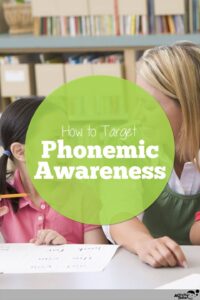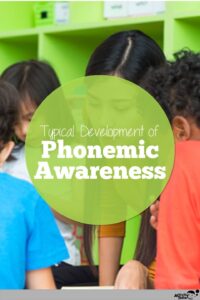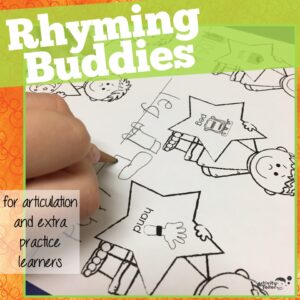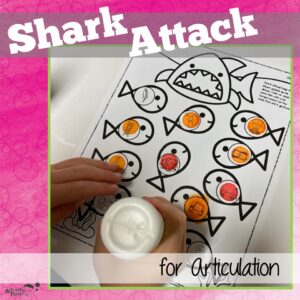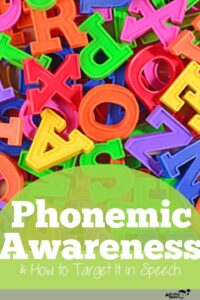Understanding the typical development of phonemic awareness skills and how to target them will set students with speech sound disorders up for greater, more lasting success!
Children who can’t identify and manipulate the sounds of spoken words are likely to have a challenging time learning how to make correct speech productions and generalize these skills adequately– AKA our articulation and phonology students!
When SLPs understand phonemic skills, we can develop appropriate expectations and provide better differentiation for our students in therapy.
Refer back to PART 1 of this series to learn WHY & HOW to assess phonemic awareness skills in students with speech sound disorders.
Remember, targeting phonemic awareness skills and articulation or phonological processing errors is an AND approach to intervention.
Typical Development of Phonemic Awareness Skills
Let’s get down to the nitty gritty!
Phoneme isolation
Phoneme isolation is the ability to hear and isolate individual sounds in spoken words. When a child can do this, you know that they understand that a word is made up of several sounds together AND the sounds can be separated from each other (Really Great Reading, 2019).
Whether students are working on adding final sounds, learning to differentiate placements of sounds, or working on a specific phoneme like /s/ in initial positions of words, understanding phoneme isolation is vital!
Example: bike starts with /b/ and ends with /k/
This skill usually develops around age 5 ½ or between the middle of kindergarten and early first grade (Moats & Tolman, 2009).
Blending
Phoneme blending is combining sounds to form a syllable or word. Working memory is activated when having to hold individual phonemes into place before putting them together.
Use tactile cues like balls made of play dough or magnetic counters to help kids beginning to learn this skill or needing additional support in this area as they work on speech sound skills like moving from sounds in syllables to words or adding two phonemes together into a two-sound blend.
Examples: /b/, /i/, /n/ to bin; /s/ and /l/ to “sl”
This skill usually develops at age 6 or between late kindergarten and early first grade (Reading Rockets, 2004).
Segmenting
Phoneme segmenting is separating a spoken word into its different sound parts. Practice this skill with students by modeling how to stretch the word into different phonemes. After a child can segment a word, then practice blending it back together.
A child’s own fingers can be used as a visual aid in stretching sounds, but other materials like clay and plastic knives are fun too!
Example: tap to /t/, /a/, /p/
This skill usually develops between ages 6 to 6 ½ or during first grade (Moats & Tolman, 2009).
Manipulating sounds
Phoneme manipulation is the most complex skill of phonemic awareness. Manipulating sounds requires children to add, remove, and change sounds within spoken words. This skill requires more advanced working memory skills and mastery of each of the lower levels of phonemic awareness.
The ability to manipulate sounds usually develops between the ages of 7 and 9 or the middle of first grade and beginning of second grade (Moats & Tolman, 2009).
Phoneme addition
Phoneme addition is the ability to add additional phonemes to existing words to create new words.
Example: adding /t/ to the word “me” creates “meet”
Phoneme deletion
Phoneme deletion is removing a phoneme from a word or blend.
Examples: deleting /c/ from “chair” creates “hair”; deleting /r/ from “taper” creates “tape”
Phoneme substitution
Phoneme substitution requires that a child delete and add phonemes to words. This skill is essential for rhyming and learning how to read and say new words.
Examples: deleting /l/ from “light” and substituting it with /r/ creates “right”; deleting /k/ from “make” and substituting it with /d/ creates “made”
Address phonemic awareness with premade resources
Students need to demonstrate their understanding of phonemic awareness during intervention for their specific speech sound goals. They also need to master these goals across multiple contexts. In order to do so, practice should happen in many different ways.
One great way to do this is by using hands-on, engaging product resources!
Help students practice rhyming while working on articulation targets in therapy with this Rhyming Buddies product.
Students work on identifying and practicing their speech sound with this fun print-and-go shark activity. This product targets many phonemes so it’s a great option for group therapy sessions!
Use this Ice Fishing articulation activity to give kids a chance to practice their sounds and stop and think about what it is they’re practicing because not every fish is a keeper. Or use this spring themed Kite articulation activity the same way because you’ll let two kites fly away!
You CAN be confident in your ability to identify and target the different areas of phonemic awareness as your work with your articulation and phonology caseloads!
You might also be interested in reading these posts:
How (and Why) to Teach Rhyming plus a Freebie!
Segmenting using Toggle Lights
References
Moats, L, & Tolman, C (2009). The Development of Phonological Skills. https://www.readingrockets.org/article/development-phonological-skills
Reading Rockets. (2004). Phonemic Awareness Assessment. https://www.readingrockets.org/article/phonemic-awareness-assessment
Really Great Reading. (2019, March 22). What is Phonemic Awareness? https://www.reallygreatreading.com/six-layers-phonemic-awareness
Encourage Curiosity! -Kim


